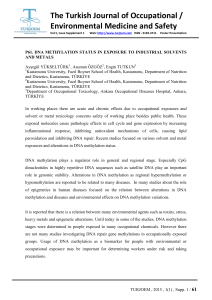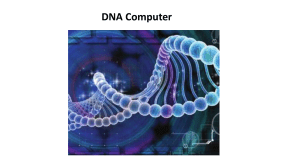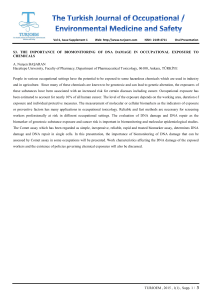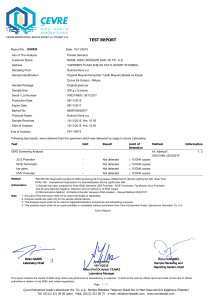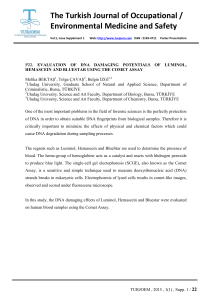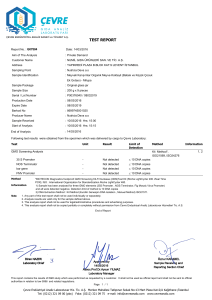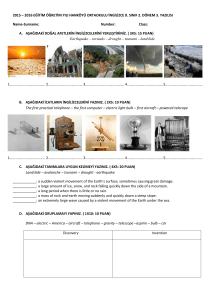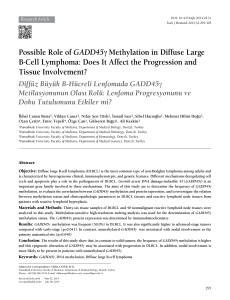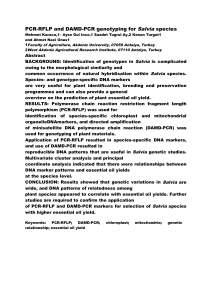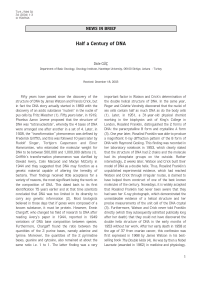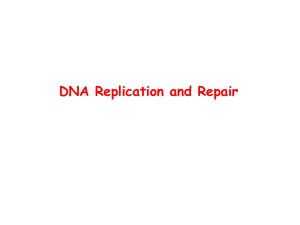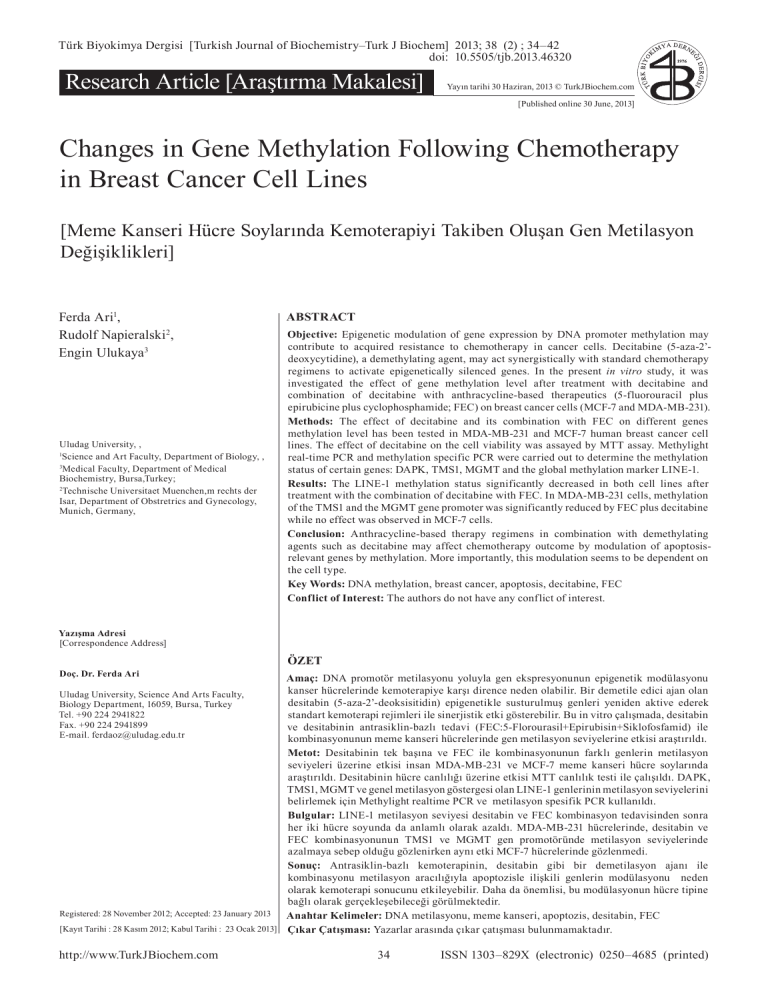
ORJİNAL
Türk Biyokimya Dergisi [Turkish Journal of Biochemistry–Turk J Biochem] 2013; 38 (2) ; 34–42
doi: 10.5505/tjb.2013.46320
Research Article [Araştırma Makalesi]
Yayın tarihi 30 Haziran, 2013 © TurkJBiochem.com
[Published online 30 June, 2013]
1976
[Meme Kanseri Hücre Soylarında Kemoterapiyi Takiben Oluşan Gen Metilasyon
Değişiklikleri]
1. ÖRNEK
Ferda Ari1,
Rudolf Napieralski2,
Engin Ulukaya3
Uludag University, ,
Science and Art Faculty, Department of Biology, ,
3
Medical Faculty, Department of Medical
Biochemistry, Bursa,Turkey;
2
Technische Universitaet Muenchen,m rechts der
Isar, Department of Obstretrics and Gynecology,
Munich, Germany,
1
ABSTRACT
Objective: Epigenetic modulation of gene expression by DNA promoter methylation may
contribute to acquired resistance to chemotherapy in cancer cells. Decitabine (5-aza-2’deoxycytidine), a demethylating agent, may act synergistically with standard chemotherapy
regimens to activate epigenetically silenced genes. In the present in vitro study, it was
investigated the effect of gene methylation level after treatment with decitabine and
combination of decitabine with anthracycline-based therapeutics (5-fluorouracil plus
epirubicine plus cyclophosphamide; FEC) on breast cancer cells (MCF-7 and MDA-MB-231).
Methods: The effect of decitabine and its combination with FEC on different genes
methylation level has been tested in MDA-MB-231 and MCF-7 human breast cancer cell
lines. The effect of decitabine on the cell viability was assayed by MTT assay. Methylight
real-time PCR and methylation specific PCR were carried out to determine the methylation
status of certain genes: DAPK, TMS1, MGMT and the global methylation marker LINE-1.
Results: The LINE-1 methylation status significantly decreased in both cell lines after
treatment with the combination of decitabine with FEC. In MDA-MB-231 cells, methylation
of the TMS1 and the MGMT gene promoter was significantly reduced by FEC plus decitabine
while no effect was observed in MCF-7 cells.
Conclusion: Anthracycline-based therapy regimens in combination with demethylating
agents such as decitabine may affect chemotherapy outcome by modulation of apoptosisrelevant genes by methylation. More importantly, this modulation seems to be dependent on
the cell type.
Key Words: DNA methylation, breast cancer, apoptosis, decitabine, FEC
Conflict of Interest: The authors do not have any conflict of interest.
Yazışma Adresi
[Correspondence Address]
Doç. Dr. Ferda Ari
ÖZET
Amaç: DNA promotör metilasyonu yoluyla gen ekspresyonunun epigenetik modülasyonu
kanser hücrelerinde kemoterapiye karşı dirence neden olabilir. Bir demetile edici ajan olan
Uludag University, Science And Arts Faculty,
desitabin (5-aza-2’-deoksisitidin) epigenetikle susturulmuş genleri yeniden aktive ederek
Biology Department, 16059, Bursa, Turkey
Tel. +90 224 2941822
standart kemoterapi rejimleri ile sinerjistik etki gösterebilir. Bu in vitro çalışmada, desitabin
Fax. +90 224 2941899
ve desitabinin antrasiklin-bazlı tedavi (FEC:5-Florourasil+Epirubisin+Siklofosfamid) ile
E-mail. [email protected]
kombinasyonunun meme kanseri hücrelerinde gen metilasyon seviyelerine etkisi araştırıldı.
Metot: Desitabinin tek başına ve FEC ile kombinasyonunun farklı genlerin metilasyon
seviyeleri üzerine etkisi insan MDA-MB-231 ve MCF-7 meme kanseri hücre soylarında
araştırıldı. Desitabinin hücre canlılığı üzerine etkisi MTT canlılık testi ile çalışıldı. DAPK,
TMS1, MGMT ve genel metilasyon göstergesi olan LINE-1 genlerinin metilasyon seviyelerini
belirlemek için Methylight realtime PCR ve metilasyon spesifik PCR kullanıldı.
Bulgular: LINE-1 metilasyon seviyesi desitabin ve FEC kombinasyon tedavisinden sonra
her iki hücre soyunda da anlamlı olarak azaldı. MDA-MB-231 hücrelerinde, desitabin ve
FEC kombinasyonunun TMS1 ve MGMT gen promotöründe metilasyon seviyelerinde
azalmaya sebep olduğu gözlenirken aynı etki MCF-7 hücrelerinde gözlenmedi.
Sonuç: Antrasiklin-bazlı kemoterapinin, desitabin gibi bir demetilasyon ajanı ile
kombinasyonu metilasyon aracılığıyla apoptozisle ilişkili genlerin modülasyonu neden
olarak kemoterapi sonucunu etkileyebilir. Daha da önemlisi, bu modülasyonun hücre tipine
bağlı olarak gerçekleşebileceği görülmektedir.
Registered: 28 November 2012; Accepted: 23 January 2013
Anahtar Kelimeler: DNA metilasyonu, meme kanseri, apoptozis, desitabin, FEC
[Kayıt Tarihi : 28 Kasım 2012; Kabul Tarihi : 23 Ocak 2013] Çıkar Çatışması: Yazarlar arasında çıkar çatışması bulunmamaktadır.
http://www.TurkJBiochem.com
34
DER
AD
RNN
MYYA
İM
EE
Kİ
1976
K BİİYYO
RRK
O
TTÜÜ
RK BİYO
TÜ
YA DERN
İM
E
DERGİSİ
Ğİ
K
RG
GİİSSİ
ER
DE
D
İ
Ğİİ
Ğ
Changes in Gene Methylation Following Chemotherapy
in Breast Cancer Cell Lines
ISSN 1303–829X (electronic) 0250–4685 (printed)
2. ÖRNEK
Introduction
Materials and Methods
Breast cancer is recognized as the most common malignancy among women. Substantial advances in therapy
and diagnosis have enhanced the survival rate of breast
cancer patients [1]. Chemotherapy plays a major role in
the treatment of patients with cancer, particularly breast cancer. Adjuvant treatment of high risk breast cancer
patients with anthracycline containing regimens (5-fluorouracil plus epirubicine plus cyclophosphamide; FEC)
has been proven to be highly effective for treating patients with advanced breast cancer [2]. Research programs
led to the identification of a variety of therapy option
for breast cancer. Epigenetic mechanisms such as DNA
methylation are now recognized to play an important
role in cancer. Altering the DNA methylation machinery
is a potentially powerful approach to cancer therapy [3].
Chemicals, Anticancer Drugs and Cell Culture
Decitabine was obtained from Sigma (St. Louis, MO).
5-Fluorouracil (5-FU; EBEWE Pharma, Austria), 4-HC
(4-hydroperoxycyclophosphamide, the active metabolite
of cyclophosphamide; NIOMECH, Germany), and epirubicine (EBEWE Pharma, Austria) were obtained from
the Pharmacy of the Uludag University Hospital, representing standard drug regimens normally used for breast cancer treatment. Stock concentrations of each drug
were prepared either in PBS (Phosphate Buffer Saline)
or in the dilution buffer provided by the drug company.
Working dilutions of the drugs were prepared from stock
solutions by diluting them in the appropriate culture medium. For each drug, four different concentrations were
used and defined as test drug concentrations (TDC).
TDC were determined by pharmacokinetic/clinical information and clinical evaluation data [21]. 100% TDC
was defined as mean plasma drug concentration assayed
after standard FEC dose administration in cancer patients [22]. Hereby, 100% TDC values (in µg/mL) were
defined as follows: 5-FU: 22.50, epirubicine: 0.50, 4-HC:
3.0. Drug concentrations used for in vitro experiments
were 200, 100, 50, and 25% of TDC.
Breast cancer cell lines MCF-7 and MDA-MB-231 were
cultured in RPMI 1640 supplemented with penicillin G
(100 U/ml), streptomycin (100 µg/ml), L-glutamine, and
10% fetal calf serum (Invitrogen, Paisley, UK) at 37 °C
in a humidified atmosphere containing 5% CO2.
DNA methylation is a covalent modification of the DNA
formed by addition of a methyl group at the 5’ carbon
residue of cytosine in so-called CpG dinucleotide repeats [4]. DNA methylation, once established, acts as
a dominant factor in down-regulation of gene expression. Aberrant DNA methylation plays also an important
role in carcinogenesis and tumor apoptosis [5]. DNA
hypermethylation occurs in many genes in breast carcinogenesis [6]. Gene-specific methylation has also been
suggested as a useful tool for prediction of prognosis or
response to treatment in early and advanced breast cancer patients [7,8]. Since epigenetic silencing of genes is
known to be associated with breast cancer progression
[5,9]. Recent studies showed that promoter methylation
of genes used as a biomarker for predicting prognosis in
breast cancer [10-12].
MTT Viability Assay
The 3-(4,5-dimethylthiazol-2-yl)-2,5-diphenyltetrazoliumbromide (MTT) cell viability assay was performed
as previously described [23]. MCF-7 and MDA-MB-231
cells were seeded per well of a 96-well plate in 200 ml
culture medium in triplicates at a density of 5x103 cells.
After overnight incubation, media were replaced by
fresh ones with or without the decitabine. Cells were
treated for 24 and 48 h with 1.25-10 µM decitabine. MTT
was supplied as a stock solution (5 mg/ml PBS, pH 7.2)
and sterile-filtered. At the end of the treatment period,
25 μl of MTT solution was added to each well and then,
after another 4 h at 37 ºC, 100 μl of solubilizing buffer
(10% SDS dissolved in 0.01 N HCl) was added to each
well. After overnight incubation, the absorbance was
determined by an ELISA plate reader (FLASH Scan S12,
Analytik Jena, Germany) at 570 nm as a read-out for cell
viability. Cell viability of treated cells was calculated in
reference to the untreated control cells using the formula:
Viability (%) = [100 x (Sample Abs)/(Control Abs)].
DNA Extraction and Bisulfite Modification
Total cellular DNA was extracted by use of the Genomic
DNA Puregene Purification Kit (Qiagen, Hilden, Germany); sodium bisulfite conversion of (un)methylated
cytosine was performed using the Epitect Bisulfit kit
Several preclinical cell line and animal models have
shown a physiological impact of the DNA methyltransferase inhibitor decitabine (5-aza-2’-deoxycytidine,
DAC) as a demethylating agent on gene expression and
tumor development [13-15]. Decitabine reverses the
hypermethylation status of CpG repeats in gene promoters inducing transcriptional reactivation of epigenetically silenced genes, ultimately leading to restoration of
apoptosis and inhibition of tumor growth [16-18]. In fact,
re-expression of silenced tumor suppressor genes with
demethylating drugs will effect inhibition of cancer cell
growth in vitro and in vivo [19,20].
In the present report, we employed a human estrogen
receptor negative, highly invasive breast cancer cell
line (MDA-MB-231) and an estrogen receptor positive, non-invasive breast cancer cell line (MCF-7) to
determine the changes in DNA methylation of DAPK
(Death-Associated Protein Kinase), TMS1 (Target of
Methylation-Induced Silencing 1; apoptosis), MGMT
(O6-Methylguanine-DNA Methyltransferase; DNA repair) LINE-1(Long-Interspersed Repetitive Elements;
global methylation marker) genes as a response to the
combined chemotherapies with decitabine.
Turk J Biochem, 2013; 38 (2) ; 34–42.
35
Ari et al.
Statistical Analyses
All statistical analyses were performed using the SPSS
20.0 statistical software for Windows. The TDC were
plotted against the corresponding cell viability values
using one-way analysis of variance (ANOVA) and the
Student’s t-test. Mann–Whitney’s U-test was used to
analyze the association between the methylation statuses of the assessed genes. A value of p<0.05 was considered statistically significant. Results are expressed as
mean values plus/minus standard deviation.
(Qiagen) according to the manufacturer’s instructions,
where one µg of DNA was converted by the following
PCR thermal cycler conditions: 5 min at 99 °C, 25 min
at 60 °C, 5 min at 99 °C, 85 min at 60 °C, 5 min at 99
°C, 175 min at 60 °C and hold at 20 °C. Treated samples
were purified and eluted in 80 µl final volume with Trisbuffered elution buffer and stored at -20 °C until further
use.
Analysis of Gene Promoter Methylation Status by
Methylight Real-time PCR Assays
Bisulfite-converted DNA was analyzed in duplicates by
the MethyLight technique as described previously [24]
employing the ABI PRISM7700 Sequence Detection
System instrument and software (Applied Biosystems,
Inc., Foster City, USA). Methylation-specific real-time
PCR for the marker genes LINE-1, DAPK, TMS1 and
MGMT were performed in a final volume of 20 µL including 10 µl 2x Quantitect Probe mastermix (Qiagen),
2 µL bisulfite-treated DNA, and assay-defined primer
and probe concentrations (Table 1). For normalization
of input of bisulfite-converted DNA, an Alu1 reference
system was used, containing a DNA-methylation statusindependent consensus sequence of the most common
Alu1 repeat families [25]. The experiment included a
no-template control and a positive control with known
DNA-methylation status. SssI-treated human chromosomal DNA (Qiagen) was used as a reference of fully methylated cytosine. Primer and probes were purchased from
Metabion (Martinsried, Germany), Applied Biosystems
(Foster City, USA), or Microsynth (Lustenau, Austria).
Analysis of Gene Promoter Methylation Status by
Methylation-specific PCR (MSP) analysis
Aberrant promoter methylation of TMS1 and DAPK
gene was determined by the method of methylation specific PCR (MSP), as reported by Herman et al. [29]. MSP
distinguishes unmethylated alleles of a given gene on
the basis of DNA sequence alterations after bisulfite treatment of DNA, which converts unmethylated but not
methylated cytosines to uracils. Subsequent PCR using
primers specific to sequences corresponding to either
methylated or unmethylated DNA sequences was then
performed.
PCR was performed using CpG WIZ TMS1/ASC and
DAP-kinase Amplification Kits (Chemicon International, Canada, USA). Primer set U will anneal to unmethylated DNA that has undergone a chemical modification.
Primer set M will anneal to methylated DNA that has
undergone a chemical modification. TThe unmethylated
or methylated sequence of TMS1 and DAPK are shown
in Table 2. PCR conditions of TMS1 and DAPK promoters: 95ºC for 5 min, 40 cycles of 95ºC for 45 s, annealing
for 56ºC 45 s and a final extension 72ºC for 60 s. PCR
products was mixed with 1.5 μl of loading dye and then
run on 2 % agarose gel. Electrophoresis was carried out
at 75 V at ambient temperature. The bands on the gels
were visualized by ethidium bromide staining.
Turk J Biochem, 2013; 38 (2) ; 34–42.
Results
Effect of Decitabine on cell viability of MCF-7 and
MDA-MB 231 cells
The effect of decitabine (1.25-10 µM) was assessed by
the MTT viability assay in MCF-7 and MDA-MB-231
breast cancer cells for 24 and 48h. Decitabine resulted
in decrease in the cell viability (about 20% percent) at
10 µM after the treatment for 48 h in both cell types (Figure 1).
DNA-Methylation Status of Genes after Anthracycline-Based Therapy and Decitabine
We examined the effects of 100% TDC FEC, 10 µM,
decitabine and their combination on DNA methylation
status of certain cancer-related genes: DAPK, TMS1,
MGMT and LINE-1 in the MDA-MB-231 and MCF-7
breast cancer cell lines by Methylight Realtime PCR Assay.
LINE-1, as a marker for genome-wide methylation status,
displays an elevated overall DNA methylation status for
untreated MCF-7 cells when compared to MDA-MB-231
cells (60.9 vs 49.7% promoter methylated reference
(PMR). The LINE-1 methylation status significantly
decreased in both cell lines after treatment with combined FEC/decitabine drug treatment (p<0.05) (Figure
2). When FEC or decitabine are used as a single drug regimens, they impacted the overall methylation status of
LINE-1 in MDA-MB-231 cells slightly, only except for
treatment of MCF-7 cells with decitabine which led to
significant reduction of the overall LINE-1 methylation
status (Figure 2).
DAPK promoter methylation was different in the MCF-7
and MDA-MB-231 cell lines, displaying a high methylation rate in the MCF-7 cell line but a low one in the
MDA-MB-231 cells. In the MCF-7 cell line, the methylation rate of the DAPK promoter was significantly
decreased by treatment with FEC, decitabine, or combination thereof. Likewise, in the MDA-MB-231 cells, the
low DNA methylation status of the DAPK gene promoter was not significantly affected by the single drugs or
combinations thereof (Figure 3).
Different from the above gene promoter DNA methylation status, the TMS1 and MGMT promoters were
completely unmethylated in the MCF-7 cells. In MDAMB-231 cells, methylation of the TMS1 gene promoter
36
Ari et al.
Table 1. Primer and probe sequences (MethyLight systems)
Gene
Sequence 5’-3’
Size of PCR
product (bp)
Reverse
GGACGTATTTGGAAAATCGGG
AATCTCGCGATACGCCGTT
81
Probe
FAM-TCGAATATTGCGTTTTCGGATCGGTTT-BHQ1
Primer
and
probe
Reference
Sequence
Reference
LINE-1
Forward
X52230.1
1524-1605
[25]
DAPK
Forward
TCGTCGTCGTTTCGGTTAGTT
Reverse
TCCCTCCGAAACGCTATC
Probe
FAM-CGA CCA TAA ACG CCA ACG CCG-BHQ1
TMS1
Forward
Reverse
Probe
67
CGT TGG AGA ATT TGA TCGTCG
79
CCC GTA ACC CTC GCG CAA
AL161787.13
[26,27]
47151-47218
FAM-AGT TTA AGA AGT TTA AGT TGA AGT TGT TGT
CGG TGT CG-BHQ1
AF184072.1
1287-1366
[28]
MGMT
Forward
CGAATATACTAAAACAACCCGCG
Reverse
GTA TTT TTT CGG GAG CGA GGC
Probe
FAM-AATCCTCGCGATACGCACCGTTTACG-BHQ1
122
X 61657
[26]
1029-1150
Alu 1
Forward
Reverse
Probe
GGTTAGGTATAGTGGTTTATATTTGTAATTTTAGTA
ATTAACTAAACTAATCTTAAACTCCTAACCTCA
VIC-CCTACCTTAACCTCCC-MGB
98
Consensus
sequence
[25]
Note: Primer and probe concentrations were as follows: uPA, 600 nmol/L primer/200 nmol/L probe; PAI-1, 600 nmol/L primer/200 nmol/L
probe; LINE-1, 300 nmol/L primer/100 nmol/L probe; DAPK, 600 nmol/L primer/200 nmol/L probe; MGMT, 600 nmol/L primer/200 nmol/L
probe; TMS1, 300 nmol/L primer/200 nmol/L probe; and Alu1, 300 nmol/L primer/100 nmol/L probe.
Abbreviations: I: Inosin binding to cytosine or uracile; BHQ: Black Hole Quencher; MGB: Minor groove binder.
Table 2. Primer sequences (MSP systems)
Gene primer
Sequence 5’-3’
Size of PCR
product (bp)
Forward GGATAGTCGGATCGAGTTAACGTC
98
and probe
Reference
DAPK
M primer
Reverse CCCTCCCAAACGCCGA
U primer
Forward GGAGGATAGTTGGATTGAGTTAATGTT
[30]
106
Reverse CAAATCCCTCCCAAACACCAA
TMS1
M primer
Forward TTGTAGCGGGGTGAGCGGC
272
Reverse AACGTCCATAAACAACAACGCG
U primer
Forward GGTTGTAGTGGGGTGAGTGGT
Reverse CAAAACATCCATAAACAACAACACA
[31]
207
Abbreviations: M: Metylated primer; U: Unmethylated Primer
Turk J Biochem, 2013; 38 (2) ; 34–42.
37
Ari et al.
Figure 1. The effects on the cell viability of decitabine for 24 and 48 h. The assays were performed as described in the materials and methods.
Figure 2. Quantitative assessment of the methylation status of the LINE-1 after treatment with 100% TDC FEC, 10 µM decitabine (DAC), or
FEC (100% TDC) plus decitabine (10 µM) for 48 h in MDA-MB-231 and MCF-7 cell lines. SssI, methylated human chromosomal DNA; PMR,
percentage methylated reference. *Significant differences of marker levels in relation to untreated control (p<0.05) are marked with asterisks.
Figure 3. Quantitative assessment of the methylation status of the DAPK after treatment with 100% TDC FEC, 10 µM decitabine (DAC), or
FEC (100% TDC) plus decitabine (10 µM) for 48 h in MDA-MB-231 and MCF-7 cell lines. SssI, methylated human chromosomal DNA; PMR,
percentage methylated reference. *Significant differences of marker levels in relation to untreated control (p<0.05) are marked with asterisks.
Turk J Biochem, 2013; 38 (2) ; 34–42.
38
Ari et al.
Discussion
was significantly reduced by decitabine, FEC, or combination thereof. Even though that the MGMT promoter
showed low methylation levels only in MDA-MB-231
cells, treatment with decitabine alone or in combination with FEC led to further reduction of the methylation
signal (Figure 4).
Epigenetic alterations associated with human breast carcinogenesis including hypermethylation of tumor suppressor genes [9] which is also important to predict the risk
of developing breast cancer [32,33]. DNA methylation is
catalyzed by DNA methyltransferases and inhibition of
this mechanism is supposed to be beneficial in the treatment of this malignant disease [34]. Accordingly, DNA
methyltransferase inhibitors such as decitabine, which
lead to cytosine demethylation, activate epigenetically
silenced genes [35-37]. This modification in genes by
the effects of decitabine makes it a promising agent for
used in cancer chemotherapy. The use of decitabine in
combination with other polychemotherapy regimens
may lead to even more effective therapy in breast cancer.
In the present study, we investigated methylation status
of genes: DAPK, TMS1 (apoptosis-inducers), MGMT
(DNA repair), and the global methylation marker LINE-
Analysis of TMS1 and DAPK gene promoter
methylation by MSP
The analysis of the methylation status of TMS1 and
DAPK apoptosis related genes in MCF-7 and MDAMB-231 breast cancers was carried out by MSP analysis.
The results of representative MSP analyses are shown in
Figure 5. MCF-7 and MDA-MB-231 cells exhibit partial
methylation of analyzed genes. In both cells, the TMS1
gene promoter was demethylated after FEC, DAC and
combination (FEC+DAC) treatment. The methylation of
DAPK promoter was decrease after treatment of DAC
and FEC plus decitabine in both cells.
Figure 4. Quantitative assessment of the methylation status of the TMS1 and MGMT after treatment with 100% TDC FEC, 10 µM decitabine
(DAC), or FEC (100% TDC) plus decitabine (10 µM) for 48 h in MDA-MB-231 cells. SssI, methylated human chromosomal DNA; PMR,
percentage methylated reference. *Significant differences of marker levels in relation to untreated control (p<0.05) are marked with asterisks.
Figure 5. Representative data showing the methylation status of TMS1 and DAPK promoter for MDA-MB-231 and MCF-7 cell lines. M and
U are the methylated and unmethylated primers, respectively. U unmethylated DNA, M methylated DNA, indicates molecular weight control
(1000pb ladder).
Turk J Biochem, 2013; 38 (2) ; 34–42.
39
Ari et al.
Conclusions
1 using DNA-methylation specific real-time PCR after
treatment of decitabine plus FEC chemotherapy regime.
In this study, we also examined the effects of decitabine
on viability of the breast cancer cell lines MDA-MB-231
and MCF-7. Decitabine lead to decrease of cell viability
at 20% percent (10 µM for 48) in both cells. In our previous study, we show that the treatment of MCF-7 and
MDA-MB-231 cells with FEC significantly reduced cell
viability in a dose-dependent manner. However, the combination of the different doses of FEC with 10 µM decitabine did not impair cell viability levels any further [38].
The methylation level of LINE-1 (long-interspersed)
repetitive elements was assessed by MethyLight assay
which estimates total genomic DNA methylation [39].
Several clinical studies associated the DNA-methylation
status of repetitive sequences like LINE-1 or Sat2 with
clinical prognosis in different cancer types [40-42]. We
demonstrated that the LINE-1 methylation status is higher in MCF-7 cells compared to MDA-MB-231 and that
incubation of the cell lines with decitabine plus FEC resulted in significant reduction of the methylation status.
Activation of general DNA repair pathways are involved
in acquired resistance of cancer cells to chemotherapy
and the MGMT (O6-methylguanine-DNA methyltransferase) gene, which is involved in the repair of alkylated
DNA lesions [43,44]. Promoter methylation of MGMT
genes associated with loss of MGMT expression and diminished DNA-repair activity [45]. Recent studies suggested that the MDA-MB-231 cell line exerts MGMT
silencing by promoter hypermethylation [46,47]. In our
hands, in MDA-MB-231 cells, the MGMT promoter showed only low methylation levels, still, treatment with
decitabine alone or in combination with FEC led to further reduction of the methylation signal. In a previously
study showed that partial demethylation of MGMT gene
prompoter when paclitaxel, adriamycin and 5-fluorouracil combined with decitabine [48].
DAPK and TMS1 are supposed to play a pivotal role
in the regulation of apoptosis, inflammatory signaling pathways, and immune response pathways [49-51],
which may be implicated in cancer progression [52,53].
In our study, we found high promoter methylation levels
of DAPK in the MCF-7 cell line and low methylation ratio in MDA-MB-231 cell line. On the opposite, the TMS1
promoter was hypermethylated in MDA-MB-231, which
is consistent with reported studies [54-56]. Correlating
results were also reported for DAPK and TMS1 mRNA
and protein expression levels in various breast cancer
cell lines [54,57]. We found that in cells treated with
decitabine, FEC, and the combination regimens, DAPK
as well as TMS1 were significantly demethylated in the
respective cell lines in a synergistic fashion. In addition, our previously data demonstrate that decitabine plus
FEC treatments increased apoptosis than decitabine or
FEC treatment alone in MCF-7 cells [38], which may be
a result of reactivation of gene expression by promoter
demethylation.
Turk J Biochem, 2013; 38 (2) ; 34–42.
In conclusion, these treatments lead to reduction of the
methylation status of promoters of the TMS1 and DAPK
genes. Furthermore epigenetic effects were also observed for FEC only regimens, which may be related to a
kind of epigenetic adaption or selection process in the
treated tumor cell population. We concluded that the
therapy of FEC plus decitabine, even FEC alone, may
affect therapy outcome by upregulation of apoptosis-relevant genes via hypomethylation.
Acknowledgement
We thank TUBITAK (The Scientific and Technical Research Council of Turkey) to support this project numbered 106S349.
Conflict of interest: Authors have no conflict of interest.
References
[1] Cheema B, Gaul CA, Lane K, Fiatarone Singh MA. Progressive
resistance training in breast cancer: a systematic review of clinical trials. Breast Cancer Res Treat 2008; 109:9-26.
[2] EBCTCG. Effects of chemotherapy and hormonal therapy for
early breast cancer on recurrence and 15-year survival: an overview of the randomised trials. Lancet 2005; 365:1687-1717.
[3] Lewandowska J, Bartoszek A. DNA methylation in cancer development, diagnosis and therapy--multiple opportunities for
genotoxic agents to act as methylome disruptors or remediators.
Mutagenesis 2011; 26:475-487.
[4] Bird A. DNA methylation patterns and epigenetic memory.
Genes Dev 2002; 16:6-21.
[5] Esteller M. Epigenetics in cancer. New Engl J Med 2008;
358:1148-1159.
[6] Dumitrescu RG. Epigenetic markers of early tumor development. Methods Mol Biol 2012; 863:3-14.
[7] Van De Voorde L, Speeckaert R, Van Gestel D, Bracke M, De
Neve W, et al. DNA methylation-based biomarkers in serum of
patients with breast cancer. Mutat Res 2012; 751:304-325.
[8] Swift-Scanlan T, Vang R, Blackford A, Fackler MJ, Sukumar
S. Methylated genes in breast cancer: associations with clinical
and histopathological features in a familial breast cancer cohort.
Cancer Biol Ther 2011; 11:853-865.
[9] Xiang TX, Yuan Y, Li LL, Wang ZH, Dan LY, et al. Aberrant
promoter CpG methylation and its translational applications in
breast cancer. Chin J Cancer. 2013; 32(1):12-20.
[10] Cho YH, Shen J, Gammon MD, Zhang YJ, Wang Q, et al. Prognostic significance of gene-specific promoter hypermethylation
in breast cancer patients. Breast Cancer Res Treat 2012; 131:197205.
[11] Mirza S, Sharma G, Parshad R, Srivastava A, Gupta SD, Ralhan
R. Clinical Significance of Promoter Hypermethylation of ERβ
and RARβ2 in Tumor and Serum DNA in Indian Breast Cancer
Patients. Ann Surg Oncol 2012; 19:3107-3115.
[12] Sharma G, Mirza S, Parshad R, Srivastava A, Gupta SD, et
al. Clinical significance of promoter hypermethylation of DNA
repair genes in tumor and serum DNA in invasive ductal breast
carcinoma patients. Life Sci 2010; 87:83-91.
[13] Liu J, Zhang Y, Xie YS, Wang FL, Zhang LJ, et al.
5-Aza-2’-deoxycytidine induces cytotoxicity in BGC-823 cells
40
Ari et al.
[30] Wethkamp N, Ramp U, Geddert H, Schulz WA, Florl AR, et
al. Expression of death-associated protein kinase during tumour
progression of human renal cell carcinomas:hypermethylationindependent mechanisms of inactivation. Eur J Cancer 2006;
42:264-274.
via DNA methyltransferase 1 and 3a independent of p53 status.
Oncol Rep 2012; 28:545-552.
[14] Ateeq B, Unterberger A, Szyf M, Rabbani SA. Pharmacological
inhibition of DNA methylation induces proinvasive and prometastatic genes in vitro and in vivo. Neoplasia 2008; 10:266-278.
[31] Conway KE, McConnell BB, Bowring CE, Donald CD, Warren
ST, Vertino PM. TMS1, a novel proapoptotic caspase recruitment domain protein, is a target of methylation-induced gene
silencing in human breast cancers. Cancer Res 2000; 60:62366242.
[15] Polakova K, Bandzuchova E, Kuba D, Russ G. Demethylating agent 5-aza-2’-deoxycytidine activates HLA-G expression
in human leukemia cell lines. Leuk Res 2009; 33:518-524.
[16] Singh KP, Treas J, Tyagi T, Gao W. DNA demethylation by
5-aza-2-deoxycytidine treatment abrogates 17 beta-estradiol-induced cell growth and restores expression of DNA repair genes
in human breast cancer cells. Cancer Lett 2012; 316:62-9.
[32] Lewis CM, Cler LR, Bu DW, Zochbauer-Muller S, Milchgrub S, et al. Promoter hypermethylation in benign breast epithelium in relation to predicted breast cancer risk. Clin Cancer
Res 2005; 11:166-172.
[17] Deng T, Zhang Y. 5-Aza-2’-deoxycytidine reactivates
expression of RUNX3 by deletion of DNA methyltransferases
leading to caspase independent apoptosis in colorectal cancer
Lovo cells. Biomed pharmacother 2009; 63:492-500.
[33] Euhus DM, Bu D, Milchgrub S, Xie XJ, Bian A, et al. DNA
methylation in benign breast epithelium in relation to age and
breast cancer risk. Cancer Epidemiol Biomarkers Prev 2008;
17:1051-1059.
[18] Chan AS, Tsui WY, Chen X, Chu KM, Chan TL, et al. Downregulation of ID4 by promoter hypermethylation in gastric adenocarcinoma. Oncogene 2003; 22:6946-6953.
[34] Billam M, Sobolewski MD, Davidson NE. Effects of a novel
DNA methyltransferase inhibitor zebularine on human breast
cancer cells. Breast Cancer Res Treat 2010; 120:581-592.
[19] Song Y, Zhang C. Hydralazine inhibits human cervical
cancer cell growth in vitro in association with APC demethylation and re-expression. Cancer Chemother Pharmacol 2009;
63:605-613.
[35] Cheng JC, Weisenberger DJ, Gonzales FA, Liang G, Xu GL,
et al. Continuous zebularine treatment effectively sustains demethylation in human bladder cancer cells. Mol Cell Biol 2004;
24:1270-1278.
[20] Steele N, Finn P, Brown R, Plumb JA. Combined inhibition of
DNA methylation and histone acetylation enhances gene re-expression and drug sensitivity in vivo. Br J Cancer 2009; 100:758763.
[36] Xu J, Zhou JY, Tainsky MA, Wu GS. Evidence that tumor necrosis factor-related apoptosis-inducing ligand induction by 5-Aza2’-deoxycytidine sensitizes human breast cancer cells to adriamycin. Cancer Res 2007; 67:1203-1211.
[21] Andreotti PE, Cree IA, Kurbacher CM, Hartmann DM, Linder
D, et al. Chemosensitivity testing of human tumors using a microplate adenosine triphosphate luminescence assay: clinical
correlation for cisplatin resistance of ovarian carcinoma. Cancer
Res 1995; 55:5276-5282.
[37] Zhang X, Yashiro M, Ohira M, Ren J, Hirakawa K. Synergic
antiproliferative effect of DNA methyltransferase inhibitor in
combination with anticancer drugs in gastric carcinoma. Cancer
Sci 2006; 97:938-944.
[22] Kurbacher CM, Cree IA, Bruckner HW, Brenne U, Kurbacher
JA, et al. Use of an ex vivo ATP luminescence assay to direct
chemotherapy for recurrent ovarian cancer. Anti-cancer Drugs
1998; 9:51-57.
[38] Ari F, Napieralski R, Ulukaya E, Dere E, Colling C, et al. Modulation of protein expression levels and DNA methylation status
of breast cancer metastasis genes by anthracycline-based chemotherapy and the demethylating agent decitabine. Cell Biochem Funct 2011; 29:651-659.
[23] Ulukaya E, Ozdikicioglu F, Oral AY, Demirci M. The MTT
assay yields a relatively lower result of growth inhibition than
the ATP assay depending on the chemotherapeutic drugs tested.
Toxicol In Vitro 2008; 22:232-239.
[39] Yang AS, Estécio MR, Doshi K, Kondo Y, Tajara EH, Issa
JP. A simple method for estimating global DNA methylation
using bisulfite PCR of repetitive DNA elements. Nucleic Acids
Res 2004; 32:38.
[24] Napieralski R, Ott K, Kremer M, Becker K, Boulesteix AL, et al.
Methylation of tumor-related genes in neoadjuvant-treated gastric cancer: relation to therapy response and clinicopathologic
and molecular features. Clin Cancer Res 2007; 13:5095-5102.
[40] Kitkumthorn N, Tuangsintanakul T, Rattanatanyong P, Tiwawech D, Mutirangura A. LINE-1 methylation in the peripheral
blood mononuclear cells of cancer patients. Clin Chim Acta
2012; 413:869-874.
[25] Weisenberger DJ, Campan M, Long TI, Kim M, Woods C, et al.
Analysis of repetitive element DNA methylation by MethyLight.
Nucl Acids Res 2005; 33:6823-6836.
[41] Jackson K, Yu MC, Arakawa K, Fiala E, Youn B, et al. DNA
hypomethylation is prevalent even in low-grade breast cancers.
Cancer Biol Ther 2004; 3:1225-1231.
[26] Friedrich MG, Weisenberger DJ, Cheng JC, Chandrasoma S,
Siegmund KD, et al. Detection of methylated apoptosis-associated genes in urine sediments of bladder cancer patients. Clin
Cancer Res 2004; 10:7457-7465.
[42] Schulz WA, Steinhoff C, Florl AR. Methylation of endogenous human retroelements in health and disease. Curr Top
Microbiol Immunol 2006; 310:211-250.
[27] Weisenberger DJ, Siegmund KD, Campan M, Young J, Long
TI, et al. CpG island methylator phenotype underlies sporadic
microsatellite instability and is tightly associated with BRAF
mutation in colorectal cancer. Nat Genet 2006; 38:787-793.
[43] Gottesman MM. Mechanisms of cancer drug resistance. Annu
Rev Med 2002; 53:615-627.
[44] Pegg AE. Mammalian O6-alkylguanine-DNA alkyltransferase:
regulation and importance in response to alkylating carcinogenic and therapeutic agents. Cancer Res 1990; 50:6119-6129.
[28] Brabender J, Usadel H, Metzger R, Schneider PM, Park J, et al.
Quantitative O(6)-methylguanine DNA methyltransferase methylation analysis in curatively resected non-small cell lung cancer: associations with clinical outcome. Clin Cancer Res 2003;
9:223-227.
[45] Morandi L, Franceschi E, de Biase D, Marucci G, Tosoni
A, et al. Promoter methylation analysis of O6-methylguanineDNA methyltransferase in glioblastoma: detection by locked
nucleic acid based quantitative PCR using an imprinted gene
(SNURF) as a reference. BMC Cancer 2010; 10:48.
[29] Herman JG, Graff JR, Myöhänen S, Nelkin BD, Baylin SB.
Methylation-specific PCR: a novel PCR assay for methylation
status of CpG islands. Proc Natl Acad Sci USA 1996; 93:98219826.
Turk J Biochem, 2013; 38 (2) ; 34–42.
[46] Hattermann K, Mehdorn HM, Mentlein R, Schultka S, HeldFeindt J. A methylation-specific and SYBR-green-based
41
Ari et al.
quantitative polymerase chain reaction technique for O6methylguanine DNA methyltransferase promoter methylation
analysis. Anal Biochem 2008; 377:62-71.
[47] Kreklau EL, Limp-Foster M, Liu N, Xu Y, Kelley MR, Erickson LC. A novel fluorometric oligonucleotide assay to measure O(6)-methylguanine DNA methyltransferase, methylpurine
DNA glycosylase, 8-oxoguanine DNA glycosylase and abasic
endonuclease activities: DNA repair status in human breast
carcinoma cells overexpressing methylpurine DNA glycosylase.
Nucleic Acids Res 2001; 29:2558-2566.
[48] Mirza S, Sharma G, Pandya P, Ralhan R. Demethylating agent
5-aza-2-deoxycytidine enhances susceptibility of breast cancer
cells to anticancer agents. Mol Cell Biochem 2010; 342:101-109.
[49] Yoo HJ, Byun HJ, Kim BR, Lee KH, Park SY, Rho SB.
DAPk1 inhibits NF-κB activation through TNF-α and INF-γinduced apoptosis. Cell Signal 2012; 24:1471-1477.
[50] Hupp TR. Death-associated protein kinase (DAPK) and
signal transduction. FEBS J 2010; 277:47.
[51] McConnell BB, Vertino PM. TMS1/ASC: The cancer connection. Apoptosis 2004; 9:5-18.
[52] Tserga A, Michalopoulos NV, Levidou G, Korkolopoulou P,
Zografos G, et al. Association of aberrant DNA methylation
with clinicopathological features in breast cancer. Oncol Rep
2012; 27:1630-1638.
[53] Kato K, Iida S, Uetake H, Takagi Y, Yamashita T, et al. Methylated TMS1 and DAPK genes predict prognosis and response to
chemotherapy in gastric cancer. Int J Cancer 2008; 122:603-608.
[54] Levine JJ, Stimson-Crider KM, Vertino PM. Effects of
methylation on expression of TMS1/ASC in human breast cancer cells. Oncogene 2003; 22:3475-3488.
[55] Mirza S, Sharma G, Prasad CP, Parshad R, Srivastava A,
et al. Promoter hypermethylation of TMS1, BRCA1, ERalpha
and PRB in serum and tumor DNA of invasive ductal breast carcinoma patients. Life Sci 2007; 81:280-287.
[56] Lehmann U, Celikkaya G, Hasemeier B, Langer F, Kreipe H.
Promoter hypermethylation of the death-associated protein kinase gene in breast cancer is associated with the invasive lobular
subtype. Cancer Res 2002; 62:6634-6638.
[57] Levy D, Plu-Bureau G, Decroix Y, Hugol D, Rostene W,
et al. Death-associated protein kinase loss of expression is a
new marker for breast cancer prognosis. Clin Cancer Res 2004;
10:3124-3130.
Turk J Biochem, 2013; 38 (2) ; 34–42.
42
Ari et al.

